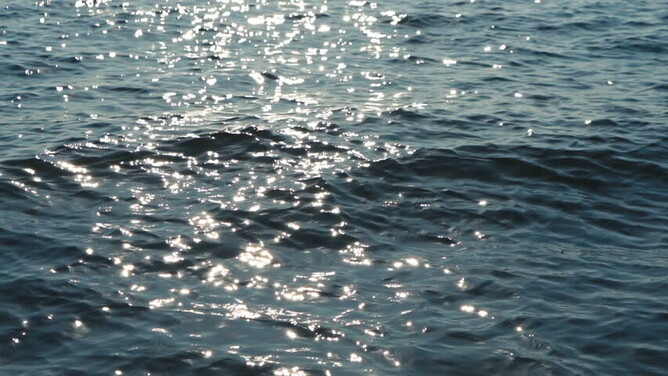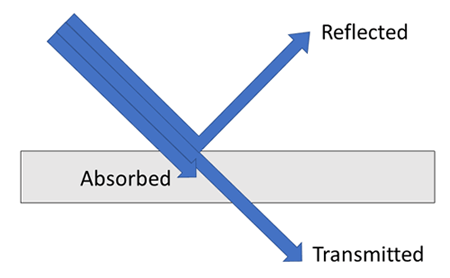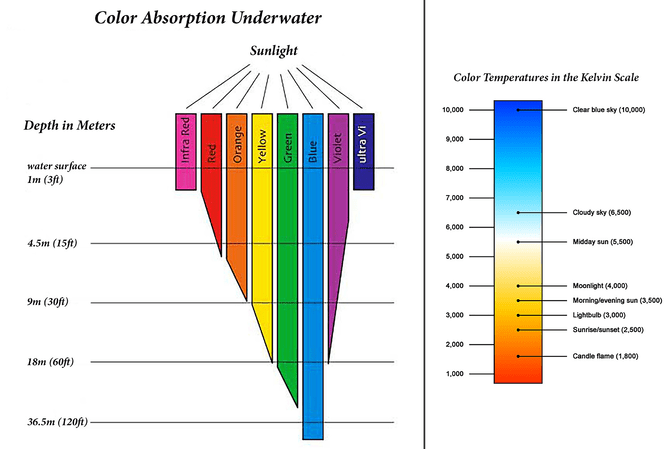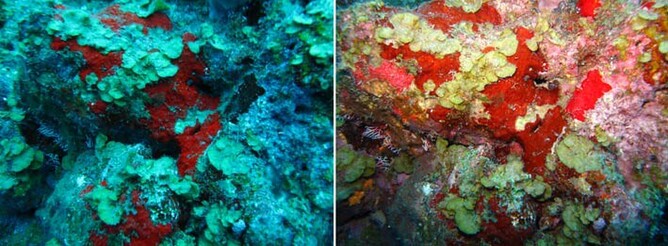Dive physics Pt. 1 - Absorption of light
It's a very different world below the surface of the water when diving - things change and it can be mind bending if you don't fully understand what is happening.
All of a sudden you feel weightless and no longer having to endure the gravitational pull of mother earth. Sound changes as it travels faster through the medium of water to our ears. Your perception of vision becomes different, everything you see appears closer and larger. Your heart rate begins to slow as part of the mammalian dive reflex, you relax as you breath deeply and enjoy the moment.
But as you descend deeper and deeper everything you're looking at starts to lose its vibrancy and colour, everything quickly starts to look greenish, brown and eventually if you're deep enough black. What exactly is going on here?
Lets look at this phenomena, otherwise known as Absorption. But first of all what is absorption?
In chemistry, absorption is a physical or chemical phenomenon or a process in which atoms, molecules or ions enter some bulk phase – liquid or solid material. This is a different process from adsorption, since molecules undergoing absorption are taken up by the volume, not by the surface (as in the case for adsorption). A more general term is sorption, which covers absorption, adsorption, and ion exchange. Absorption is a condition in which something takes in another substance and in this case we are talking about water taking in light (from our Sun).
Even on the sunny days, much of the suns light is lost in the first couple of meters of water. This is due to reflection; some of the sun’s rays hit the surface and are deflected away. Refraction also impacts light penetration, light is bent as it passes through water and will not continue in a straight line. Finally diffusion plays a part. Diffusion is when light passes through water and becomes scattered. These three characteristics of light occur on the calmest of days – add into the equation some surface waves and you will have even less available light. Waves can also stir up sand and other foreign particles, further blocking or diverting light. When we talk about visibility in the water we are talking about the turbidity.
As well as these effects light is also absorbed when it enters a media of greater density (water). The degree of absorption will depend to some extent on the colour of the light. White light, in fact consists of a series of colours - the spectrum. The different wavelengths of light penetrate to different depths when they pass through water due to the process of absorption.
The colours of the spectrum are red, orange, yellow, green, blue, indigo and violet. Red light has the lowest energy level and violet has the highest, therefor it is the colour red that is first to disappear. This visible light, the portion of the electromagnetic spectrum that is visible to the human eye, is in the range of wavelengths between 400 to 700 nanometers.
Water acts as a blue filter so white light will be seen as varying hues of blue until eventually even this colour is absorbed. As a result an object which appears red or orange at the surface, very quickly loses its colour as it is taken deeper until it eventually is perceived as black.
On many occasions while running deep courses we have sometimes taken red objects with us on the dive and even wore red Hawaiian shirts over the top of our wetsuits to demonstrate absorption. It can be quite astounding to view red objects deep underwater when they appear dark or even black, then by switching on a torch and illuminating them the colour red again appears - try it!
So how do we compensate for this loss of light?
To make up for lost hue you can compensation with an artificial lighting source. Underwater torches are the answer and if your a photographer underwater strobes can help restore lost colour and contrast in photos. Strobes can supply light in a shadow environment, which is a dominant effect underwater. Photographers may also choose to use colour compensating filters on their camera to correct the loss of colour.
The dramatic loss of colours can be corrected with the help of colour compensating filters.
As part of your total diving system carrying a torch really is essential and especially if you want to truly see something in all its natural, colourful glory. Torches can also be a great way of underwater communication as well as illuminating the hard to see areas like rocky overhangs. Just a word of warning though, try not to go blinding aquatic life by shining a high power torch into their eyes. It can be damaging to them and also you may be putting them at risk to natural predators by highlighting their location. A better approach if you wish to view aquatic life is to illuminate away from them and slowly bring the edge of the beam towards them just enough to enable you to observe their behaviour.
We sell a range of torches in our store click here to view.
Finally diving in low visibility or total darkness can be a thrilling experience but can also be a trigger for anxiety for those untrained or less experienced. A great way to learn new skills like underwater communication with an underwater light source is to sign up to the SSI Night and Limited Visibility Program.
The SSI Night Diving and Limited Visibility Specialty is the best way to learn about night diving and practice the techniques you will need to become a safe and confident night diver. Remember, diving does not end when the sun goes down! Become a night diver and meet the incredible marine life that only comes out at night. Night diving requires a different set skills from diving during the day and this course is designed to introduce them to you in a fun and safe environment equipping you with the skills to dive at night safely and comfortably or in limited visibility conditions.
Have you seen the light yet? Join us today for all your training requirements.
For more information on the SSI Night and Limited Visibility Program click here





